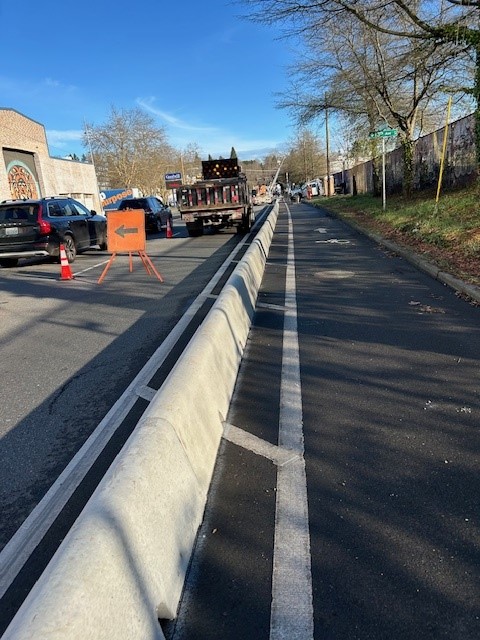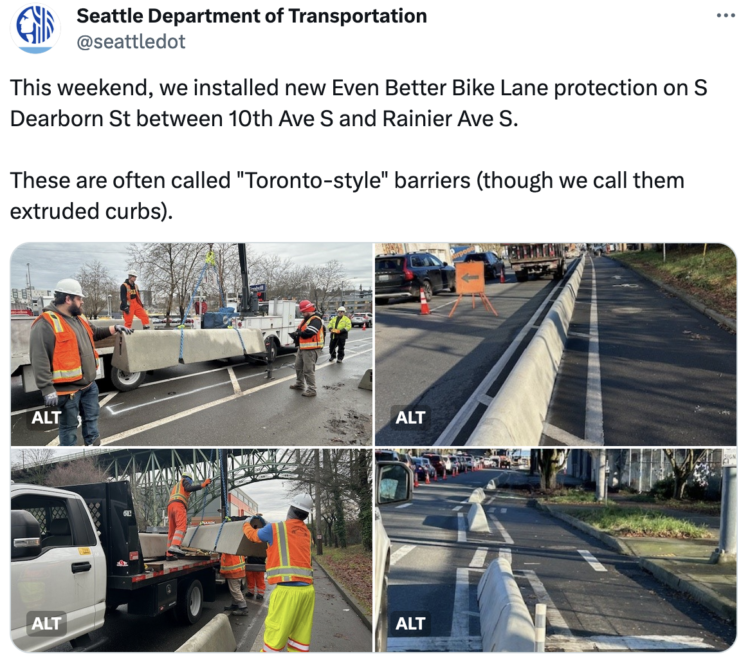SDOT installs its latest ‘even better bike lane’ barrier on Dearborn Street
 Photo from SDOT.
Photo from SDOT.A couple blocks of the S Dearborn Street bike lane now has a knee-high concrete curb separating it from the four lanes of general purpose traffic between Rainier Ave S and 10th Ave S.
The Toronto" barriers are shorter than highway-style Jersey barriers but significantly taller than a standard curb. They are fabricated in advance and have pass-through channels to allow water to drain. SDOT is testing them out as a way to expand its toolset for protecting bike lanes in hopes of finding options that they can install as cost-effective retrofits for the city's many paint-only or plastic-post-protected bike lanes.
SDOT has previously installed this Toronto style of barrier on S Columbian Way on Beacon Hill. They also tested out a shorter curb on NE 40th Street under the University Bridge. They also announced improved bike lane barriers on S Othello Street between 45th Ave S and MLK as well as 9th Ave south of Mercer Street, though progress has been slow.
There are a couple reasons why Seattle needs bike lane protection methods that are both effective and lower-cost. The most obvious is that we could install more of them for the same budget. But a perhaps even more practical reason is that there are limits under state and local laws to how much work SDOT can conduct using in-house crews before they need to put projects out to bid to private contractors. A major bike lane build with standard curbs, landscaping, new drainage, etc. can easily go beyond the in-house project limit and need to go out for bid. Sending projects out for bid can add significant delays and costs. For a major street rebuild project that is going to bid anyway, it makes sense to build bikes lanes into the remade streetscape. But for projects where SDOT is adding or upgrading bike lanes on existing streets, having options that SDOT crews can install themselves is key to building out many miles of bike lane improvements as part of the department's regular work.
In addition to testing their durability (Dearborn will definitely give them a good stress test), SDOT also needs to gather user feedback. For example, how often should there be breaks in the wall to allow people to enter and exit the bike lane? With the plastic posts, people can leave the bike lane whenever they want, useful for accessing a left turn lane for example. This can also be important if there is standing water or some other kind of obstacle in the bike lane. But the more gaps there are in a bike lane barrier, the more likely it is for someone to stop or park a car there.
SDOT also noted that it's not always easy or quick to acquire barriers that do not have local suppliers. Parking stop curbs are so easy to get because there's already a big local market for them. Toronto-style barriers are a bit more niche, at least at the moment. But if a department as large as SDOT decided they wanted a lot of them, that market could change.
In all, the Dearborn test probably won't make a giant difference for users because the new barriers start after the worst part of the biking on that street: Crossing the freeway ramps. But fixing those freeway crossings would be a different project, and one requiring partnership with WSDOT. You can see what it's like to ride the upgraded lanes in this video from Bob Svercl.
